Module1 Unit 1 Whose bag is this课件+音频(共38张PPT)外研版七年级下册
文档属性
| 名称 | Module1 Unit 1 Whose bag is this课件+音频(共38张PPT)外研版七年级下册 | 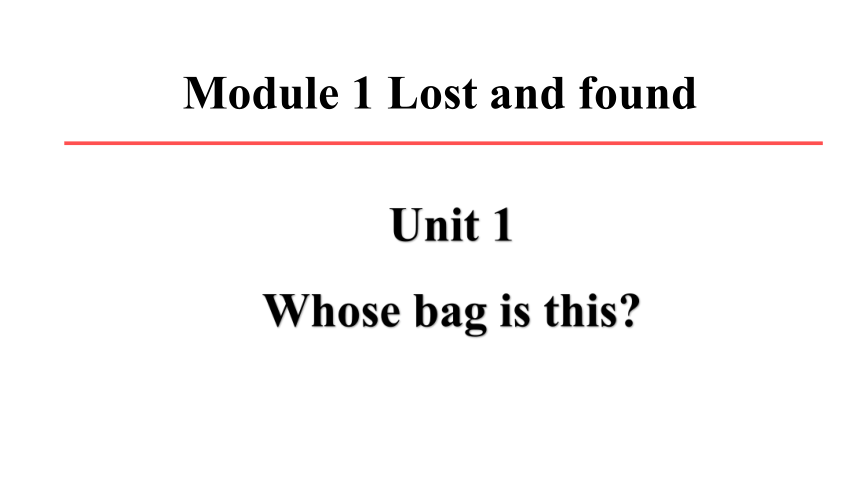 | |
| 格式 | pptx | ||
| 文件大小 | 15.4MB | ||
| 资源类型 | 教案 | ||
| 版本资源 | 外研版 | ||
| 科目 | 英语 | ||
| 更新时间 | 2024-02-01 21:49:07 | ||
图片预览

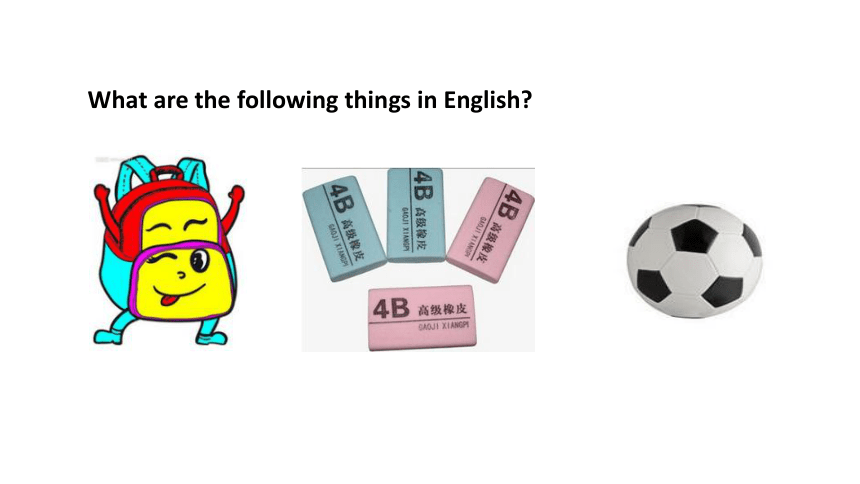
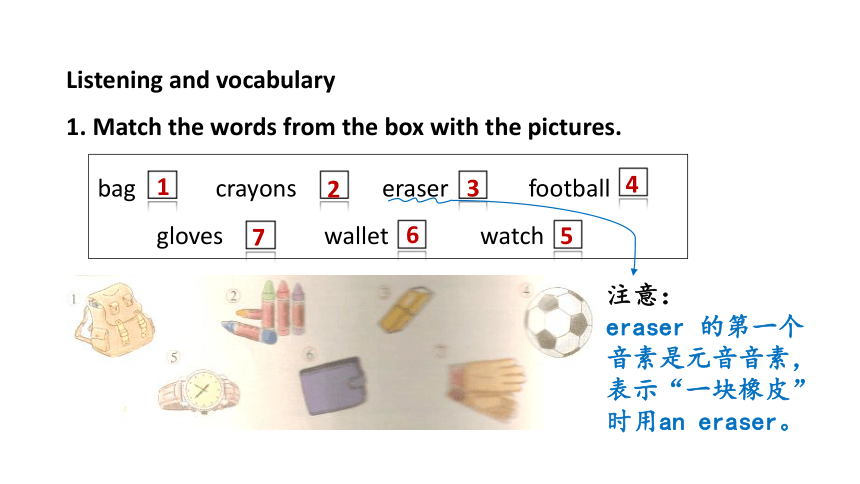
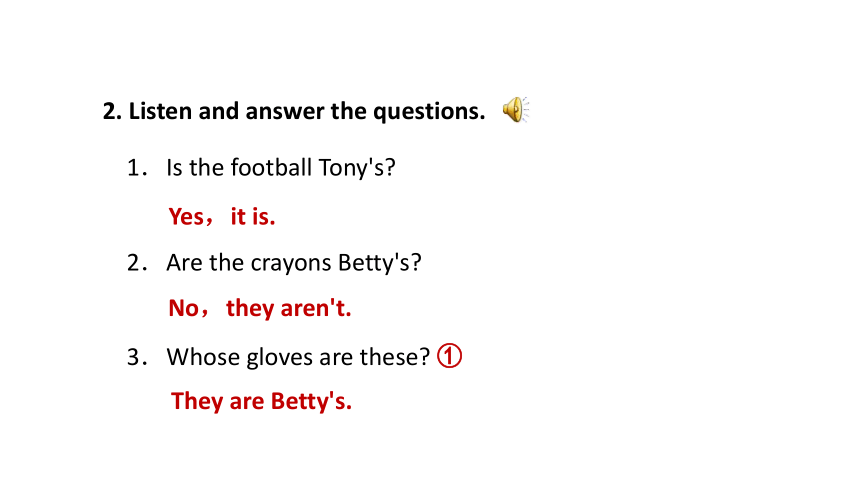
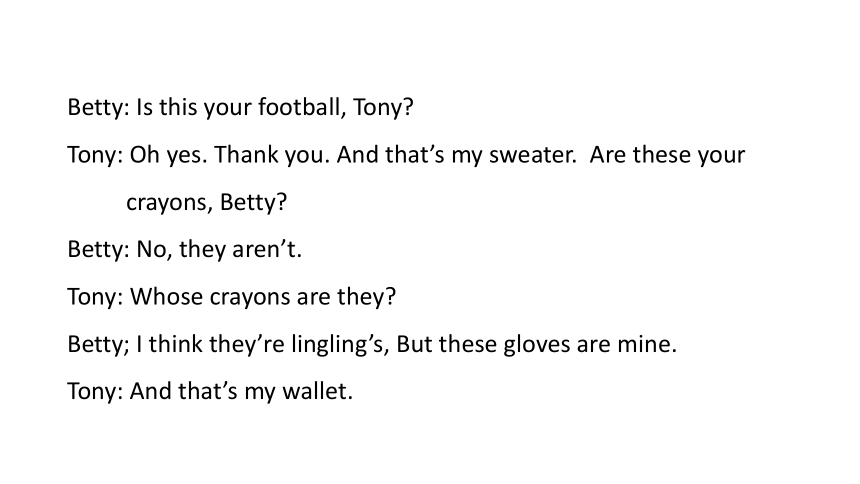
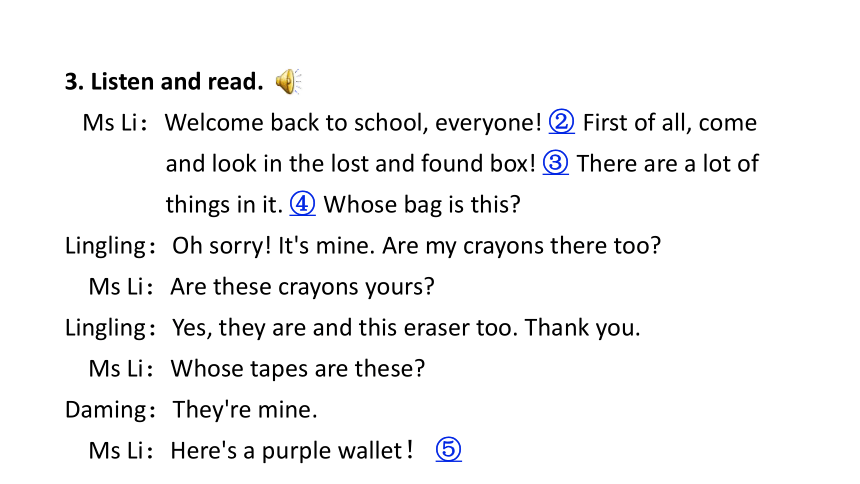
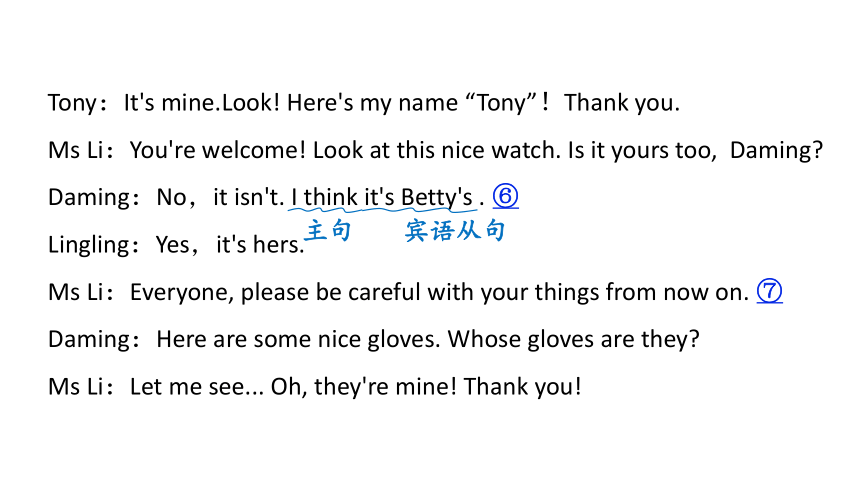
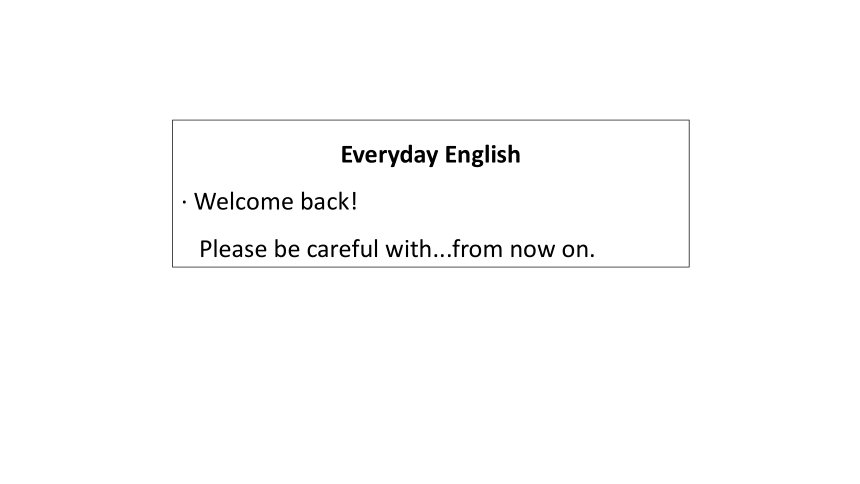
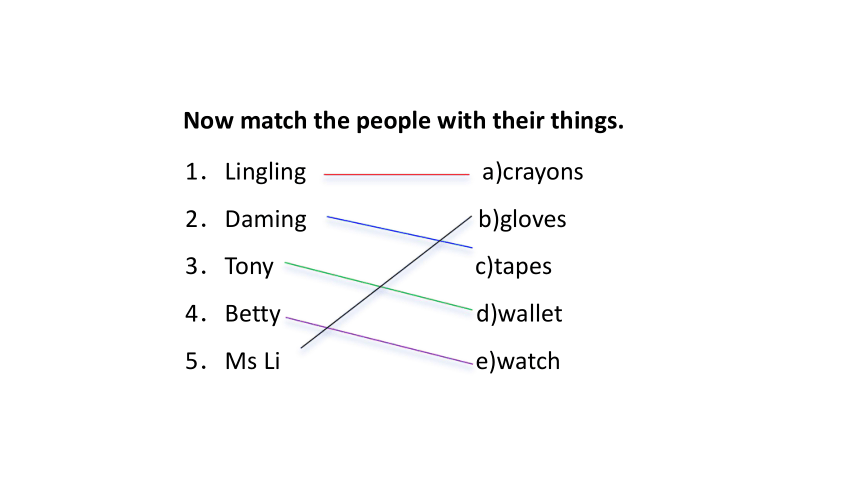
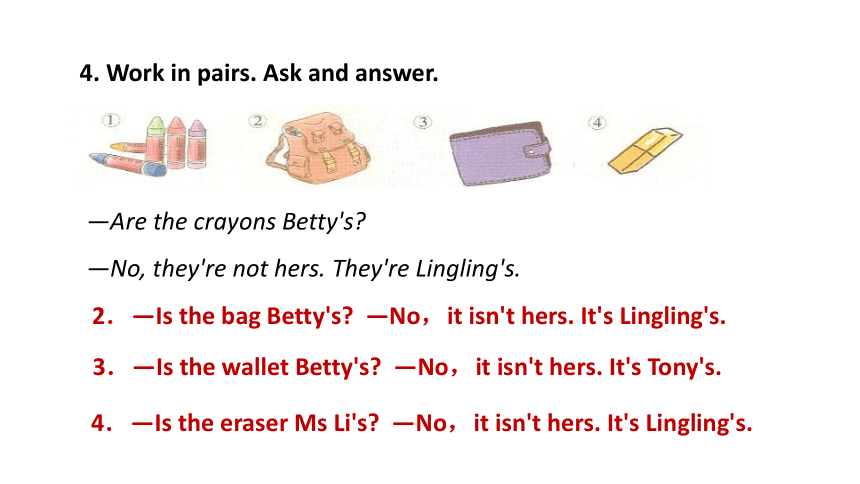
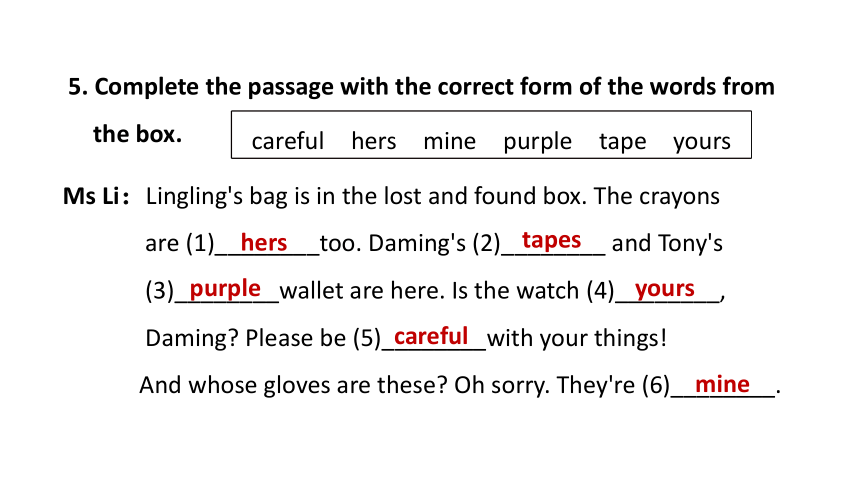
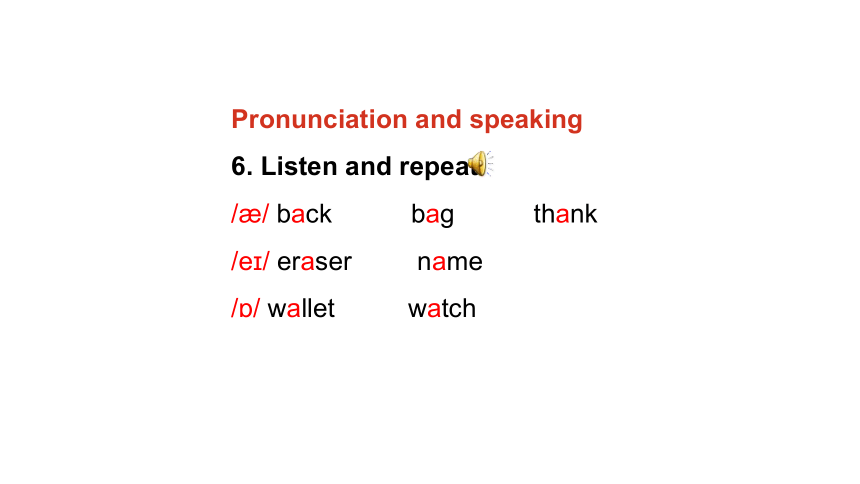
文档简介
(共38张PPT)
Module 1 Lost and found
Unit 1
Whose bag is this
What are the following things in English
Listening and vocabulary
1. Match the words from the box with the pictures.
bag crayons eraser football
gloves wallet watch
1
3
2
4
5
6
7
注意:
eraser 的第一个音素是元音音素,表示“一块橡皮”时用an eraser。
2. Listen and answer the questions.
Yes,it is.
No,they aren't.
They are Betty's.
1.Is the football Tony's
2.Are the crayons Betty's
3.Whose gloves are these ①
Betty: Is this your football, Tony
Tony: Oh yes. Thank you. And that’s my sweater. Are these your crayons, Betty
Betty: No, they aren’t.
Tony: Whose crayons are they
Betty; I think they’re lingling’s, But these gloves are mine.
Tony: And that’s my wallet.
3. Listen and read.
Ms Li:Welcome back to school, everyone! ② First of all, come and look in the lost and found box! ③ There are a lot of things in it. ④ Whose bag is this
Lingling:Oh sorry! It's mine. Are my crayons there too
Ms Li:Are these crayons yours
Lingling:Yes, they are and this eraser too. Thank you.
Ms Li:Whose tapes are these
Daming:They're mine.
Ms Li:Here's a purple wallet! ⑤
Tony:It's mine.Look! Here's my name “Tony”!Thank you.
Ms Li:You're welcome! Look at this nice watch. Is it yours too, Daming
Daming:No,it isn't. I think it's Betty's . ⑥
Lingling:Yes,it's hers.
Ms Li:Everyone, please be careful with your things from now on. ⑦
Daming:Here are some nice gloves. Whose gloves are they
Ms Li:Let me see... Oh, they're mine! Thank you!
主句
宾语从句
Everyday English
· Welcome back!
Please be careful with...from now on.
Now match the people with their things.
1.Lingling a)crayons
2.Daming b)gloves
3.Tony c)tapes
4.Betty d)wallet
5.Ms Li e)watch
4. Work in pairs. Ask and answer.
—Are the crayons Betty's
—No, they're not hers. They're Lingling's.
2.—Is the bag Betty's —No,it isn't hers. It's Lingling's.
3.—Is the wallet Betty's —No,it isn't hers. It's Tony's.
4.—Is the eraser Ms Li's —No,it isn't hers. It's Lingling's.
5. Complete the passage with the correct form of the words from the box.
careful hers mine purple tape yours
Ms Li:Lingling's bag is in the lost and found box. The crayons
are (1)________too. Daming's (2)________ and Tony's
(3)________wallet are here. Is the watch (4)________,
Daming Please be (5)________with your things!
And whose gloves are these Oh sorry. They're (6)________.
hers
tapes
purple
yours
careful
mine
Pronunciation and speaking
6. Listen and repeat.
/ / back bag thank
/e / eraser name
/ / wallet watch
7. Work in groups of three or four. Put four or five school things on the desk. Now ask and answer.
A:Is this your pen
B:Yes,it's mine.
A:Whose pencil is it
C:It's ...,
① Whose gloves are these
whose /hu z/ pron. 谁的
常用来对物主代词或名词所有格进行提问,询问物品的归属。
考点1
who’s 和 whose 同 音, 但 who’s 是 who is 的缩略形式,意为 “是谁”,而 whose 是 who 的所有格形式, 意为“谁的”。
考向
e.g. This is my bike. 这是我的自行车。
→ Whose bike is this 这是谁的自行车?
(对物主代词提问)
The computer is Jane’s. 这台电脑是简的。
→ Whose is the computer 这台电脑是谁的。
(对名词所有格提问)
考题1:[丽水改编] —W ID card is on the desk
—Oh, it’s mine.
hose
glove /ɡl v/ n. 手套
(1)glove 常以复数形式出现,gloves单独作主语时,谓语动词用复数形式。
(2)表示数量时常用“基数词+pair(s)+of+可数名词复数”结构,在句中作主语时,谓语动词与pair(s) 在数上保持一致。
(3)类似的名词还有:glasses(眼镜);trousers(裤子);shorts(短裤);socks(袜子);shoes(鞋子)等。
考点2
考题2:[连云港 ] —Whose ________(手套) are these They aren’t mine.
—They’re Lucy’s.
gloves
e.g. The gloves look very beautiful. 这手套看起来很漂亮。
Two pairs of gloves are on the desk. 书桌上有两副手套。
返回
② Welcome back to school, everyone!
welcome /'welk m/ v.& int. 欢迎
考点3
welcome 常用词组:
welcome back 欢迎回来
welcome (back) to+ 地点名词 欢迎(回)到某地
welcome sb. to... 欢迎某人来 ......
e.g. Welcome back! It’s nice to see you again.
欢迎回来!很高兴又见到你了。
Welcome to China. 欢迎来到中国。
Hello, welcome home. 嗨,欢迎回家。
They welcome me to their home. 他们欢迎我到他们家。
当接副词here, there, home等时,介词 to要去掉。
拓展:welcome 用作形容词。You’re welcome. 用于礼貌地回答别人的感谢。常用来回答别人感谢的表达还有:“That’s all right. /Don’t mention it./My pleasure.”。
e.g. —Thanks for helping me do the housework.谢谢你帮我做家务。
—You’re welcome. 不用谢。
考题3:[宿迁] —It’s really kind of you to help me with Maths, Jack.
— ______.
A. It doesn’t matter B. All right
C. You’re welcome D. Never mind
【点拨】情景交际法。It doesn’t matter 没关系;All right 好吧;You’re welcome 不客气;Never mind 没关系。上文句意提示用You’re welcome 来应答感谢用语。
C
返回
③ First of all, come and look in the lost and found box!
first of all 首先;第一
考点4
first of all 常放在句首作状语,强调首要
的事情或动作。表示顺序,下文往往有 next/
second, then 等。
e.g. First of all, you should do your homework.
首先,你应该做家庭作业。
First of all, let me tell you something about it.
首先,让我给你讲讲它的情况。
考题4:[云南 ] We will spend the coming week together. So _____, let’s know each other’s names.
A. in the end B. all the time C. first of all D. as a result
【点拨】用短语辨析法解题。in the end“最后”;all the time“一直”;first of all“首先;第一”;as a result“因此”。由句意“……所以首先,让我们知道一下彼此的名字。”可知答案。
C
lose /lu z/ v. 失去(过去式为 lost)
(1)lose 是及物动词,意为“失去”,其过去式为lost。
(2)lose 的反义词为find(发现;找到),其过去式为found。
(3)lost and found 失物招领
考点5
语境助记:Tom lost his keys and he couldn’t find them.
汤姆把他的钥匙弄丢了,而且他找不到它们了。
返回
④ There are a lot of things in it.
there be 句型
考点6
不能用have或has替换there be句型中的be动词。
there be 表示 “存在, 有”,说明某地有某物或某人。
如果there be 后为可数名词单数或不可数名词时,be 动词用is; 若为可数名词复数时,be 动词用are。
如果there be 后的主语有两个或两个以上,be 动词的形式根据“就近原则”确定,即be动词与离它最近的主语在数上保持一致。
e.g. There are many beautiful flowers in the park.
公园里有许多漂亮的花。
There is a tree in front of the house. 房子前面有一棵树。
There is a chair and two desks in the room.
在这个房间里有一把椅子和两张书桌。
There are two boys and a girl in the classroom.
在教室里有两个男孩和一个女孩。
there be 表示“有”时,侧重于客观存在,常用于表示“某地有某人/ 某物”。
have/has 表示“有”时,侧重于所属关系,有“归……所有”之意,常用于表示“某人/ 某物有……”。
辨析:there be 与have/has
考题5:[恩施] There _____ some milk and several apples in the fridge.
A. is B. are C. be
A
返回
⑤ Here’s a purple wallet!
here is/are ...(用于刚找到某人或某物时)……在这儿
这里有: (1)Here is+ 单数可数名词或不可数名词.
(2)Here are+ 复数可数名词.
e.g. Here is your English book. 你的英语书在这里。
Here are some delicious dumplings.
这里有一些美味的饺子。
考点7
提示:若主语是人称代词,句子不可倒装。
e.g. Here he comes. 他来了。
Here you are! 给你!
以here 或there 开头的句子,如果主语是名词,句子要完全倒装,即:“Here/There+ 谓语动词+ 主语(名词). ”。
考题6:Hey, Nick. _______ comes the last bus! Hurry up, or we’ll have to walk home.
A. This B. There C. That D. It
【点拨】语法分析法。空格所在句的主语是名词,且完全倒装,应该以here 或there 开头。
B
返回
⑥ I think it’s Betty’s.
“I think+ 宾语从句 .”句式
考点8
在“I think+ 宾语从句 .”中,如果宾语从句表达否定意义,应变为“I don’t think+ 肯定形式的宾语从句 .”,这叫作“否定前移”。
常用来表达说话者 的观点或看法,语气较委婉。
考题7: I think it’s easy to write Chinese words. (改为否定句)
I _________ _________ it’s easy to write Chinese words.
don’t think
e.g. I think you are right. 我认为你是对的。
So I think it’s easy for you to find me.
所以我认为你很容易找到我。
I don’t think they can play football.
我认为他们不会踢足球。
返回
⑦ Everyone, please be careful with your things from now on.
be careful with 小心(对待)……
考点9
careful 常用词组:
be careful 小心 (可单独使用)
be careful about... 注意 / 小心……
be careful to do sth. 小心做某事
考题8:This picture is too expensive. Please be careful _______ it.
A. for B. from C. at D. with
D
e.g. Please be careful with the knife, or you’ll cut yourself.
请小心那把刀子,否则你会割伤自己。
Be careful! The stairs are wet. 当心!楼梯是湿的。
We must be careful to read every word.
我们必须认真读每一个单词。
from now on 从现在开始
e.g. From now on I will study hard.
从现在开始,我要努力学习。
Let’s try our best from now on.
从现在开始,让我们尽最大努力吧。
考点10
常与一般将来时连用,也可用于祈使句中。
返回
本节课主要练习了听力,掌握了知识点welcome, everyone, first of all, lose, There are a lot of things in it., 名词所有格, be careful with, from now on的用法,谈论了物品的归属。
Module 1 Lost and found
Unit 1
Whose bag is this
What are the following things in English
Listening and vocabulary
1. Match the words from the box with the pictures.
bag crayons eraser football
gloves wallet watch
1
3
2
4
5
6
7
注意:
eraser 的第一个音素是元音音素,表示“一块橡皮”时用an eraser。
2. Listen and answer the questions.
Yes,it is.
No,they aren't.
They are Betty's.
1.Is the football Tony's
2.Are the crayons Betty's
3.Whose gloves are these ①
Betty: Is this your football, Tony
Tony: Oh yes. Thank you. And that’s my sweater. Are these your crayons, Betty
Betty: No, they aren’t.
Tony: Whose crayons are they
Betty; I think they’re lingling’s, But these gloves are mine.
Tony: And that’s my wallet.
3. Listen and read.
Ms Li:Welcome back to school, everyone! ② First of all, come and look in the lost and found box! ③ There are a lot of things in it. ④ Whose bag is this
Lingling:Oh sorry! It's mine. Are my crayons there too
Ms Li:Are these crayons yours
Lingling:Yes, they are and this eraser too. Thank you.
Ms Li:Whose tapes are these
Daming:They're mine.
Ms Li:Here's a purple wallet! ⑤
Tony:It's mine.Look! Here's my name “Tony”!Thank you.
Ms Li:You're welcome! Look at this nice watch. Is it yours too, Daming
Daming:No,it isn't. I think it's Betty's . ⑥
Lingling:Yes,it's hers.
Ms Li:Everyone, please be careful with your things from now on. ⑦
Daming:Here are some nice gloves. Whose gloves are they
Ms Li:Let me see... Oh, they're mine! Thank you!
主句
宾语从句
Everyday English
· Welcome back!
Please be careful with...from now on.
Now match the people with their things.
1.Lingling a)crayons
2.Daming b)gloves
3.Tony c)tapes
4.Betty d)wallet
5.Ms Li e)watch
4. Work in pairs. Ask and answer.
—Are the crayons Betty's
—No, they're not hers. They're Lingling's.
2.—Is the bag Betty's —No,it isn't hers. It's Lingling's.
3.—Is the wallet Betty's —No,it isn't hers. It's Tony's.
4.—Is the eraser Ms Li's —No,it isn't hers. It's Lingling's.
5. Complete the passage with the correct form of the words from the box.
careful hers mine purple tape yours
Ms Li:Lingling's bag is in the lost and found box. The crayons
are (1)________too. Daming's (2)________ and Tony's
(3)________wallet are here. Is the watch (4)________,
Daming Please be (5)________with your things!
And whose gloves are these Oh sorry. They're (6)________.
hers
tapes
purple
yours
careful
mine
Pronunciation and speaking
6. Listen and repeat.
/ / back bag thank
/e / eraser name
/ / wallet watch
7. Work in groups of three or four. Put four or five school things on the desk. Now ask and answer.
A:Is this your pen
B:Yes,it's mine.
A:Whose pencil is it
C:It's ...,
① Whose gloves are these
whose /hu z/ pron. 谁的
常用来对物主代词或名词所有格进行提问,询问物品的归属。
考点1
who’s 和 whose 同 音, 但 who’s 是 who is 的缩略形式,意为 “是谁”,而 whose 是 who 的所有格形式, 意为“谁的”。
考向
e.g. This is my bike. 这是我的自行车。
→ Whose bike is this 这是谁的自行车?
(对物主代词提问)
The computer is Jane’s. 这台电脑是简的。
→ Whose is the computer 这台电脑是谁的。
(对名词所有格提问)
考题1:[丽水改编] —W ID card is on the desk
—Oh, it’s mine.
hose
glove /ɡl v/ n. 手套
(1)glove 常以复数形式出现,gloves单独作主语时,谓语动词用复数形式。
(2)表示数量时常用“基数词+pair(s)+of+可数名词复数”结构,在句中作主语时,谓语动词与pair(s) 在数上保持一致。
(3)类似的名词还有:glasses(眼镜);trousers(裤子);shorts(短裤);socks(袜子);shoes(鞋子)等。
考点2
考题2:[连云港 ] —Whose ________(手套) are these They aren’t mine.
—They’re Lucy’s.
gloves
e.g. The gloves look very beautiful. 这手套看起来很漂亮。
Two pairs of gloves are on the desk. 书桌上有两副手套。
返回
② Welcome back to school, everyone!
welcome /'welk m/ v.& int. 欢迎
考点3
welcome 常用词组:
welcome back 欢迎回来
welcome (back) to+ 地点名词 欢迎(回)到某地
welcome sb. to... 欢迎某人来 ......
e.g. Welcome back! It’s nice to see you again.
欢迎回来!很高兴又见到你了。
Welcome to China. 欢迎来到中国。
Hello, welcome home. 嗨,欢迎回家。
They welcome me to their home. 他们欢迎我到他们家。
当接副词here, there, home等时,介词 to要去掉。
拓展:welcome 用作形容词。You’re welcome. 用于礼貌地回答别人的感谢。常用来回答别人感谢的表达还有:“That’s all right. /Don’t mention it./My pleasure.”。
e.g. —Thanks for helping me do the housework.谢谢你帮我做家务。
—You’re welcome. 不用谢。
考题3:[宿迁] —It’s really kind of you to help me with Maths, Jack.
— ______.
A. It doesn’t matter B. All right
C. You’re welcome D. Never mind
【点拨】情景交际法。It doesn’t matter 没关系;All right 好吧;You’re welcome 不客气;Never mind 没关系。上文句意提示用You’re welcome 来应答感谢用语。
C
返回
③ First of all, come and look in the lost and found box!
first of all 首先;第一
考点4
first of all 常放在句首作状语,强调首要
的事情或动作。表示顺序,下文往往有 next/
second, then 等。
e.g. First of all, you should do your homework.
首先,你应该做家庭作业。
First of all, let me tell you something about it.
首先,让我给你讲讲它的情况。
考题4:[云南 ] We will spend the coming week together. So _____, let’s know each other’s names.
A. in the end B. all the time C. first of all D. as a result
【点拨】用短语辨析法解题。in the end“最后”;all the time“一直”;first of all“首先;第一”;as a result“因此”。由句意“……所以首先,让我们知道一下彼此的名字。”可知答案。
C
lose /lu z/ v. 失去(过去式为 lost)
(1)lose 是及物动词,意为“失去”,其过去式为lost。
(2)lose 的反义词为find(发现;找到),其过去式为found。
(3)lost and found 失物招领
考点5
语境助记:Tom lost his keys and he couldn’t find them.
汤姆把他的钥匙弄丢了,而且他找不到它们了。
返回
④ There are a lot of things in it.
there be 句型
考点6
不能用have或has替换there be句型中的be动词。
there be 表示 “存在, 有”,说明某地有某物或某人。
如果there be 后为可数名词单数或不可数名词时,be 动词用is; 若为可数名词复数时,be 动词用are。
如果there be 后的主语有两个或两个以上,be 动词的形式根据“就近原则”确定,即be动词与离它最近的主语在数上保持一致。
e.g. There are many beautiful flowers in the park.
公园里有许多漂亮的花。
There is a tree in front of the house. 房子前面有一棵树。
There is a chair and two desks in the room.
在这个房间里有一把椅子和两张书桌。
There are two boys and a girl in the classroom.
在教室里有两个男孩和一个女孩。
there be 表示“有”时,侧重于客观存在,常用于表示“某地有某人/ 某物”。
have/has 表示“有”时,侧重于所属关系,有“归……所有”之意,常用于表示“某人/ 某物有……”。
辨析:there be 与have/has
考题5:[恩施] There _____ some milk and several apples in the fridge.
A. is B. are C. be
A
返回
⑤ Here’s a purple wallet!
here is/are ...(用于刚找到某人或某物时)……在这儿
这里有: (1)Here is+ 单数可数名词或不可数名词.
(2)Here are+ 复数可数名词.
e.g. Here is your English book. 你的英语书在这里。
Here are some delicious dumplings.
这里有一些美味的饺子。
考点7
提示:若主语是人称代词,句子不可倒装。
e.g. Here he comes. 他来了。
Here you are! 给你!
以here 或there 开头的句子,如果主语是名词,句子要完全倒装,即:“Here/There+ 谓语动词+ 主语(名词). ”。
考题6:Hey, Nick. _______ comes the last bus! Hurry up, or we’ll have to walk home.
A. This B. There C. That D. It
【点拨】语法分析法。空格所在句的主语是名词,且完全倒装,应该以here 或there 开头。
B
返回
⑥ I think it’s Betty’s.
“I think+ 宾语从句 .”句式
考点8
在“I think+ 宾语从句 .”中,如果宾语从句表达否定意义,应变为“I don’t think+ 肯定形式的宾语从句 .”,这叫作“否定前移”。
常用来表达说话者 的观点或看法,语气较委婉。
考题7: I think it’s easy to write Chinese words. (改为否定句)
I _________ _________ it’s easy to write Chinese words.
don’t think
e.g. I think you are right. 我认为你是对的。
So I think it’s easy for you to find me.
所以我认为你很容易找到我。
I don’t think they can play football.
我认为他们不会踢足球。
返回
⑦ Everyone, please be careful with your things from now on.
be careful with 小心(对待)……
考点9
careful 常用词组:
be careful 小心 (可单独使用)
be careful about... 注意 / 小心……
be careful to do sth. 小心做某事
考题8:This picture is too expensive. Please be careful _______ it.
A. for B. from C. at D. with
D
e.g. Please be careful with the knife, or you’ll cut yourself.
请小心那把刀子,否则你会割伤自己。
Be careful! The stairs are wet. 当心!楼梯是湿的。
We must be careful to read every word.
我们必须认真读每一个单词。
from now on 从现在开始
e.g. From now on I will study hard.
从现在开始,我要努力学习。
Let’s try our best from now on.
从现在开始,让我们尽最大努力吧。
考点10
常与一般将来时连用,也可用于祈使句中。
返回
本节课主要练习了听力,掌握了知识点welcome, everyone, first of all, lose, There are a lot of things in it., 名词所有格, be careful with, from now on的用法,谈论了物品的归属。
同课章节目录
- Module 1 Lost and found
- Unit 1 Whose bag is this?
- Unit 2 Are they yours?
- Unit 3 Language in use
- Module 2 What can you do ?
- Unit 1 I can play the piano
- Unit 2 I can run really fast
- Unit 3 Language in use
- Module 3 Making plans
- Unit 1 What are you going to do at the weekends?
- Unit 2 We're going to cheer the players.
- Unit 3 Language in use
- Module 4 Life in the future
- Unit 1 Everyone will study at home
- Unit 2 Every family will have a small plane.
- Unit 3 Language in use
- Module 5 Shopping
- Unit 1 What can I do for you?
- Unit 2 You can buy everything on the Internet
- Unit 3 Language in use
- Module 6 Around town
- Unit 1 Could you tell me how to get to the Nationa
- Unit 2 The London Eye is on your right.
- Unit 3 Language in use
- Revision module A
- Module 7 My past life
- Unit 1 I was born in a small village.
- Unit 2 I was born in Quincy.
- Unit 3 Language in use
- Module 8 Story time
- Unit 1 Once upon a time….
- Unit 2 Goldilocks hurried out of the house.
- Unit 3 Language in use
- Module 9 Life history
- Unit 1 He left school and began work at the age of
- Unit 2 He decided to be an actor.
- Unit 3 Language in use
- Module 10 A holiday journey
- Unit 1 What did you do?
- Unit 2 This morning we took a walk.
- Unit 3 Language in use
- Module 11 Body language
- Unit 1 They touch noses!
- Unit 2 Here are some ways to welcome them.
- Unit 3 Language in use
- Module 12 Western music
- Unit 1 It's so beautiful!
- Unit 2 Vienna is the centre of European classical
- Unit 3 Language in use
- Revision module B
